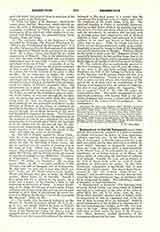

Redemption (in the Old Testament) means either strictly deliverance by payment of a price or ransom, or simply deliverance by power, as from oppression, violence, captivity, etc. In the Hebrew Text, the idea of redemption is directly expressed by the verbs gaal and padah, and by their derivatives to which the word kopher (ransom) is intimately related. Of these two verbs, the former, ga’dl, is used technically in the Mosaic Law, of the redemption by price of an inheritance, or of things vowed, or of tithes; the latter, padah, of redeeming the first-born of children or of animals. Outside the Law, and in relation to the God of Israel, both verbs are used of simple salvation or deliverance by power. In the New Testament, redemption is specifically that of man from sin by Christ’s death. The idea is distinctly expressed by the verb Greek: lutroumai (from lutron, “a ransom”) and its derivatives; it is also directly conveyed by the term agorazo (to buy, to purchase) and by its compound eksagorazo. The following is simply a treatment of legal redemption.
REDEMPTION OF PERSONS.—The first-born male of every Jewish family was consecrated to Yahweh and had to be redeemed at the price of five sicles or about $2.75 (Ex., xiii, 2, 13; Num., xviii, 16; etc.). Every other Israelite, whether male or female, could be consecrated to God by a personal vow, or by the vow of those to whom he or she belonged. Jephte‘s actual immolation of his daughter in consequence of his vow concerning her (Judges, xi, 31-39), was contrary to the Law. Many Israelites carried out their dedication to God, under the form of the Nazarite vow. Most, however, availed themselves of the redemption allowed by the Law. The sum then to be paid as ransom for males between 20 and 60 years of age was 50 sacred sicles; for females of a similar age, 30 sicles; for boys between 5 and 20 years old, 20 sicles, and for girls of a corresponding age, 10 sides; for male children from one month to 5 years of age, 5 sicles, and for those of the female sex, 3; and finally, for old nen over 60 years of age, 15 sicles, and for old women, 10. The poor who could not afford this amount had to pay the price fixed by the priest, according to their means (Lev., xxvii, 2-8). Persons lying under anathema could not be redeemed.
REDEMPTION OF ANIMALS.—According to the Mosaic Law, the first-born male of animals was sacred to the Lord, and, if a first-born of legally clean animals, and without blemish, had to be offered in sacrifice. As unclean animals should not be immolated to Yahweh, their first-born was either to be redeemed according to the valuation of the priest, with the addition of one-fifth of the value, or be sold and the price given to the priest (Lev., xxvii, 27). The first-born of an ass, however, had to be redeemed with a lamb, or, if not redeemed, put to death (Ex., xiii, 13). Outside of the first-born; any animal could be dedicated to God by vow. It could be ransomed only if it were legally unfit for sacrifice, in which case the price for its redemption was left to the valuation of the priest, to which was added one-fifth of the value (Lev., xxvii, 11-13).
REDEMPTION OF LAND, HOUSES, AND TITHES.—The landed property which, in whole or in part, an Israelite was forced by poverty to sell, could be redeemed by his next of kin (the Go’el), or by the man himself when again able to do so. The redemption price was then fixed according to the number of years yet to elapse before the Jubilee Year, at which time the property would have freely reverted to its original owner or to his heir (Lev., xxv, 25-28). A piece of land dedicated to God could also be redeemed. Its value was reckoned according to the amount of seed required to sow it, and a reduction made in proportion to the number of years till the next Jubilee Year. The owner of the land might redeem it at this price, plus one-fifth; and if unredeemed, it went to the priestly domain at the year of Jubilee. But if the dedicant of the land had himself purchased it from a third person who had sold it because of his poverty, then at the Jubilee it reverted to the latter, and the dedicant had to recompense the sanctuary by paying its redemption price calculated as before (Lev., xxvii, 16-25). With regard to the redemption of sold houses, the Law distinguished between dwellings in walled cities and dwellings in unwalled places. For the former houses, the right of redemption lasted only a full year from the day of sale, at the end of which they fell forever to their respective purchaser. For the latter, there was no term fixed for their redemption, and if unredeemed before the Jubilee they then freely reverted to their original owners. The houses of the Levites, however, could be redeemed at any time, and reverted to them if unredeemed before the year of Jubilee (Lev., xxv, 29-34). Houses which had been simply vowed to God could be ransomed upon the payment of the value fixed by the priest, plus one-fifth of that value (Lev., xxvii, 14, 15). Tithes belonged to God as the real owner of the land, and hence could not be made the subject of vows. Tithes of agricultural produce might be commuted for their money value, plus one-fifth; but the tithes of cattle could not be redeemed (Lev., xxvii, 31-33).
FRANCIS E. GIGOT

